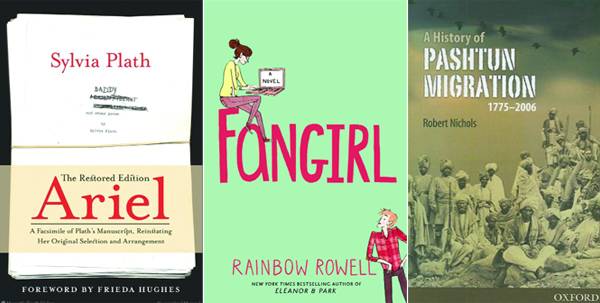
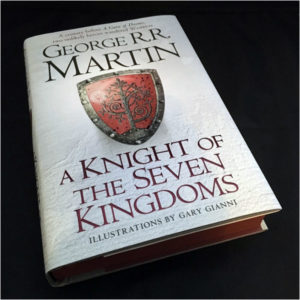
A Knight of the Seven Kingdoms
George RR Martin
Bantam (hardcover), 2015
PRs 1595
Taking place nearly a century before the events of A Game of Thrones, A Knight of the Seven Kingdoms compiles the first three official prequel novellas to George RR Martin’s on-going masterwork, A Song of Ice and Fire. These never-before-collected adventures recount an age when the Targaryen line still holds the Iron Throne, and the memory of the last dragon has not yet passed from living consciousness.
Before Tyrion Lannister and Podrick Payne, there was Dunk and Egg. A young, naïve but ultimately courageous hedge knight, Ser Duncan the Tall towers above his rivals—in stature if not experience. Tagging along is his diminutive squire, a boy called Egg—whose true name is hidden from all he and Dunk encounter. Though more improbable heroes may not be found in all of Westeros, great destinies lay ahead for these two… as do powerful foes, royal intrigue, and outrageous exploits.
Featuring more than 160 all-new illustrations by Gary Gianni, A Knight of the Seven Kingdoms is a must-have collection that proves chivalry isn’t dead—yet.

Fangirl: A Novel
Rainbow Rowell
MACMILLAN (paperback), 2013
PRs 795
In Rainbow Rowell’s Fangirl, Cath is a Simon Snow fan. Okay, the whole world is a Simon Snow fan, but for Cath, being a fan is her life—and she’s really good at it. She and her twin sister, Wren, ensconced themselves in the Simon Snow series when they were just kids; it’s what got them through their mother leaving.
Reading. Rereading. Hanging out in Simon Snow forums, writing Simon Snow fan fiction, dressing up like the characters for every movie premiere.
Cath’s sister has mostly grown away from fandom, but Cath can’t let go. She doesn’t want to.
Now that they’re going to college, Wren has told Cath she doesn’t want to be roommates. Cath is on her own, completely outside of her comfort zone. She’s got a surly roommate with a charming, always-around boyfriend, a fiction-writing professor who thinks fan fiction is the end of the civilised world, a handsome classmate who only wants to talk about words… And she can’t stop worrying about her dad, who’s loving and fragile and has never really been alone.
For Cath, the question is: Can she do this?
Can she make it without Wren holding her hand? Is she ready to start living her own life? Writing her own stories?
And does she even want to move on if it means leaving Simon Snow behind?
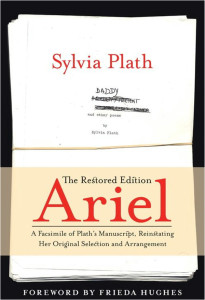
Ariel: The Restored Edition
Sylvia Plath
Harper Perennial Modern Classics (paperback), 2005
PRs 745
Sylvia Plath’s famous collection, as she intended it. When Sylvia Plath died, she not only left behind a prolific life but also her unpublished literary masterpiece, Ariel. When her husband, Ted Hughes, first brought this collection to life, it garnered worldwide acclaim, though it wasn’t the draft Sylvia had wanted her readers to see. This facsimile edition restores, for the first time, Plath’s original manuscript — including handwritten notes — and her own selection and arrangement of poems. This edition also includes in facsimile the complete working drafts of her poem “Ariel”, which provide a rare glimpse into the creative process of a beloved writer. This publication introduces a truer version of Plath’s works, and will no doubt alter her legacy forever.
This PS edition features an extra 16 pages of insights into the book, including author interviews, recommended reading, and more.
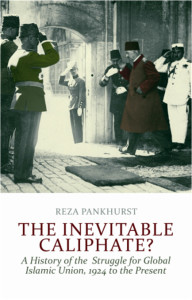
The Inevitable Caliphate?
Reza Pankhurst
Hurst (paperback), 2013
PRs 3625
While in the West ‘the Caliphate” evokes overwhelmingly negative images, throughout Islamic history it has been regarded as the ideal Islamic polity. In the wake of the “Arab Spring” and the removal of long-standing dictators in the Middle East, in which the dominant discourse appears to be one of the compatibility of Islam and democracy, reviving the Caliphate has continued to exercise the minds of its opponents and advocates. Reza Pankhurst’s book contributes to our understanding of Islam in politics, the path of Islamic revival across the last century and how the popularity of the Caliphate in Muslim discourse waned and later re-emerged. Beginning with the abolition of the Caliphate, the ideas and discourse of the Muslim Brotherhood, Hizbut Tahrir, Al Qaeda and other smaller groups are then examined. A comparative analysis highlights the core commonalities as well as differences between the various movements and individuals, and suggests that as movements struggle to re-establish a polity, which expresses the unity of the ummah (or global Islamic community), the Caliphate has alternatively been ignored, had its significance minimised or denied, reclaimed and promoted as a theory and symbol in different ways, yet still serves as a political ideal for many.
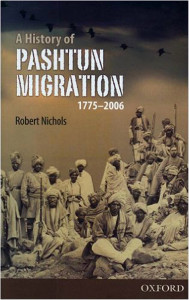
A history of Pashtun Migration
Robert Nichols
Oxford (hardcover), 2008
PRs 850
For centuries Pashtuns from Peshawar and today’s Pakistan-Afghan borderlands have circulated throughout the sub-continent and the Indian Ocean region. This interregional history of migration and mobility in the modern period from 1775 to 2006 follows Pashtun individuals and communities as they left homelands and responded to colonial and post-colonial opportunities and challenges in eighteenth century Rohilkhand, nineteenth century northern India and Hyderabad, Pakistan after 1947, and the Gulf region from the nineteenth century to the present. Pashtuns in permanent or temporary diaspora were transformed by the range of possible social consequences as they circulated in South Asia and the greater Indian Ocean region, variously experiencing degrees of assimilation, integration, sustained ethnic self-awareness, and, increasingly, notions of “national” identity. Pashtuns in home villages and in distant locations exhibited personal initiative and agency even as they were affected by wider European imperial policies, national and interregional political competition, and the evolving pressures of an expanding world economy. This work illuminates the history of Pashtuns and Pakistan and offers insight into how Asian regional populations have been integrated into, and often subordinated by, the dynamics of contemporary globalisation.

